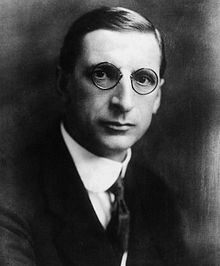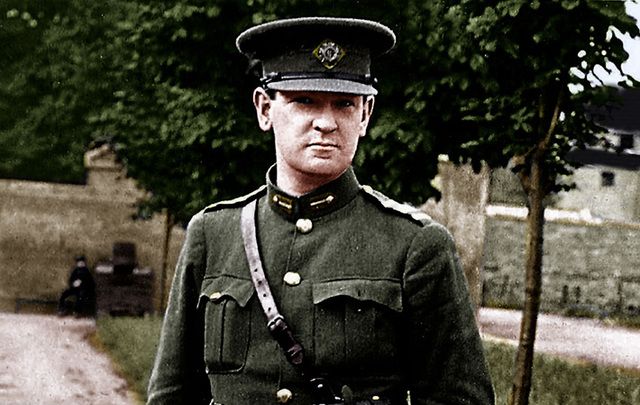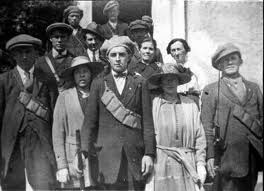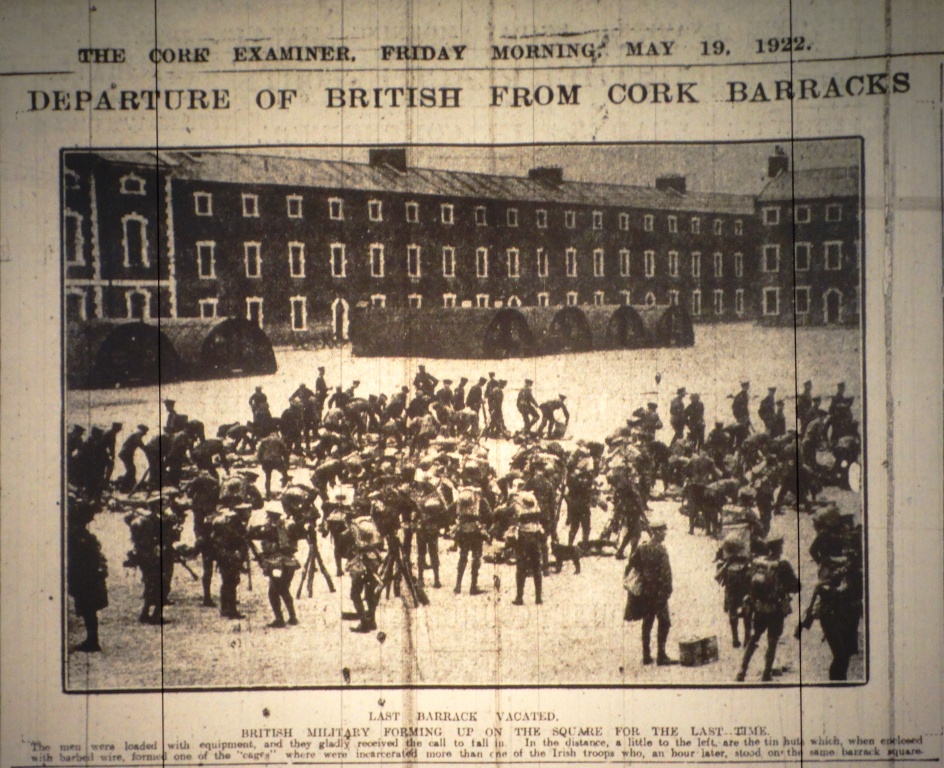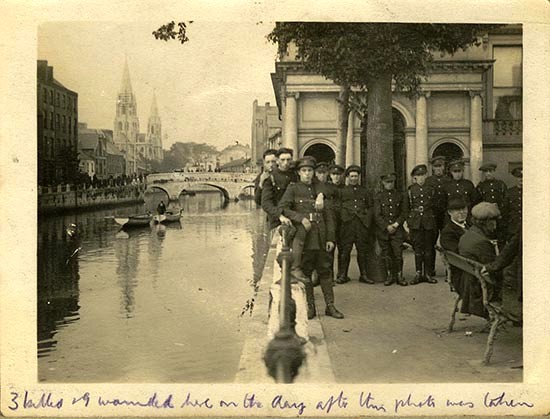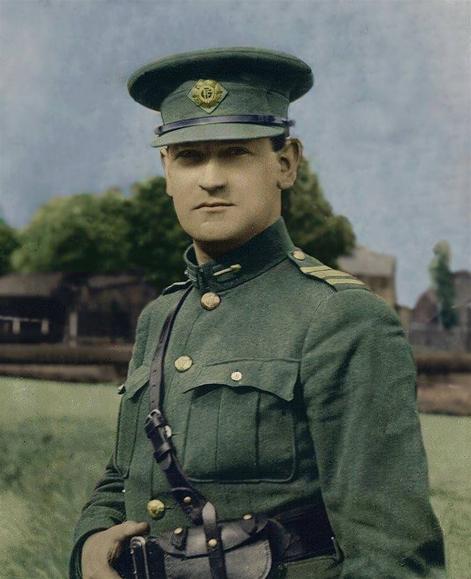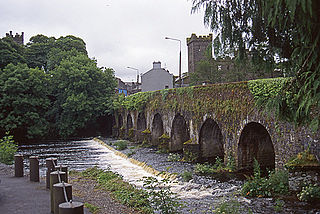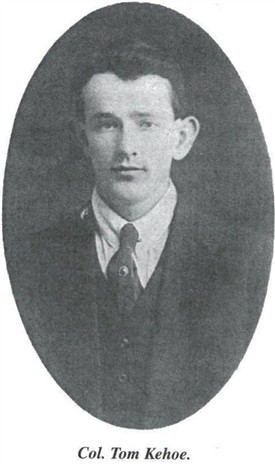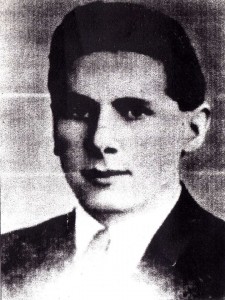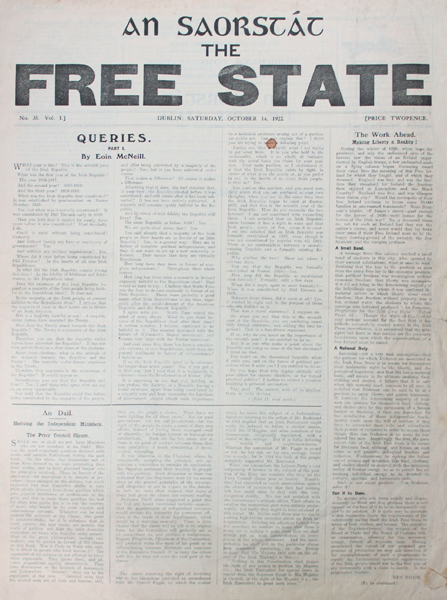1922
-
Anti-Treaty Rally in Cork
Eamon de Valera
19 February 1922An Anti-Treaty rally was held in Cork on Sunday 19 February. The attendees included Eamon de Valera, Cathal Brugha, Constance Markiewicz and Sean MacSwiney T.D.. Two large platforms were erected for the speakers on Grand Parade. Several thousand people filled the streets. Companies of Volunteers lined South Mall, Grand Parade and Washington Street.
Lord Mayor Donal O’Callaghan spoke first, followed by Eamon de Valera. De Valera’s speech was short, during which he said that if the Treaty was signed under duress, then the men who went over broke their faith with the Irish people. If they signed it without duress, they were traitors to their cause. He said he believed it was signed under duress. He said the forthcoming election was an attempt to get the Irish people to recognise partition, to get them to go into the British Empire and accept a British monarch.
After de Valera had finished his speech Cathal Brugha, Mary MacSwiney, David Kent, Liam Mellows and Countess Markievicz addressed the crowd.
A ballot of staff of the Cork General Post Office resulted in an almost unanimous vote in favour of strike action. Police Barracks at Mitchelstown and Castletownbere were handed over by British forces to the Irish Republican Army.
References
Cork Examiner, 19 February 1922 -
Pro-Treaty Rally in Cork
Michael Collins
12 March 1922On Sunday 12 March 1922, Michael Collins and prominent supporters took part in a Pro-Treaty Rally in Cork City. 50,000 people gathered to listen to speeches on Grand Parade, some from as far away as Sullivan’s Quay.
During his speech, Michael Collins said that de Valera and his followers were suggesting that martyrdom and destruction were better than materialism and slavery. He said there was no slavery under the Treaty. He said the Anti-Treaty side were inciting mutiny for their own ends, and were jeopardising Ireland’s independence and progress.
Towards the end of the meeting revolver shots were fired into the air. Liam De Róiste then said “We were not afraid of the Black-and-Tans, and we are not afraid of them.” He then asked to crowd to support the Treaty in the forthcoming general election.
References
Cork Examiner, 13 March 1922 -
The Dunmanway Killings
Mid-Cork IRA column
29 April 1922Between 26 and 29 April 1922, there were thirteen violent killings in West Cork which later became known as “The Dunmanway Massacre”.
The first fatality was I.R.A Commandant, Michael O’Neill, 1st Battalion, 3rd Cork Brigade, who was shot and killed at a house near Ovens. He had called to the house, owned by a family named Hornibrook, on army business and was shot by a person in the house named Woods. Later that night three civilian residents of Dunmanway were shot dead when they answered their front doors. Two others were seriously wounded.
The shootings continued in Dunmanway the following night, with several wounded and five civilians killed, varying in age from 18 to 60. The majority of victims were Protestant. The Dáil cabinet expressed its horror at the events. More killings occurred on 29 April.
As a result of these murders, many Protestant families moved from the West Cork area, fleeing to Dublin or England in the fear they would be targeted. Brigade Commandant Tom Hales pledged protection for all citizens of the area, irrespective of creed, and ordered IRA members to lay down their arms or face severe penalties.
References
Cork Examiner, 27 April – 1 May 1922;
Keane, Barry (2014) Massacre in West Cork : the Dunmanway and Ballygroman killings. Mercier Press: Cork -
Victoria Barracks Hand Over
Cork Examiner 19 May 1922
18 May 1922On 18 May 1922, British Forces handed Victoria Barracks (later renamed Collins Barracks) to the Irish Republican Army. British Troops left the barracks at 7pm and embarked the S.S. Classic on Custom House Quay. Before they left they lowered the Union Jack and took it with them.
Irish Troops remained at the rear gate until the British Military had handed over the keys of the main gate to I.R.A Captain MacNeill. At 8pm a force of 200 Irish Soldiers of the 1st Cork Brigade, armed with rifles, entered the Barracks by the front gate and formally took possession of the Barracks.
Youghal Military Barracks and Admiralty House in Cobh were also handed over to Irish Forces on this day.
References
Cork Examiner, 19 May 1922 -
The Battle for Cork
National Army troops in Cork, 1922
8 August 1922Between 24 July and 10 August 1922 Pro-Treaty forces implemented a series of sea landings in a strategic offensive to take the South and West of Ireland from the anti-Treaty Republicans who held Munster and Connacht. The largest of these took place on 8 August, and were overseen by Emmet Dalton. The Irish Independent of 10 August reported on successful landings at Passage West, Union Hall and Youghal.
Irregular forces were routed at Union Hall. They had tried to destroy the pier, but the boat carrying Free State troops landed successfully at high tide. At Passage West, 50 or more Irregulars were captured. The remaining anti-Treaty forces fought to impede the advance of National troops to Cork.
After a three day intensive battle for Douglas, on the outskirts of Cork city, the National Army once again was able to push the Republican Forces back because of their armoured cars and Artillery. As the National Army drew closer to the city of Cork the Republican Forces pulled out in small sections while others kept the pressure on. The offices of “The Cork Examiner” and “The Cork Constitution” were burnt out by retreating Irregulars, as well as a number of barracks and the Technical school. The Admiralty House in Cobh was also burned.
On 10 August, Free State troops entered Cork unopposed, the Republican forces having left their positions. Crowds of civilians greeted them.
Irregulars evacuated Midleton and Castlemartyr and set fire to Castlemartyr Barracks. IRA Commander Liam Lynch abandoned Fermoy.
The Cork No. 1 Brigade officers held a meeting later in August to decide to continue the war. Liam Lynch’s Brigade had a new Operating Order No. 19, to set up flying columns to resume the guerrilla fighting. Already, Republicans within the city had started hitting back. There were snipers at night targeting National Army patrols and headquarters. There was even a daylight bomb explosion at Parliament Bridge wounding several army recruits. Eamon de Valera appealed for a ceasefire due to the futility of the fighting. The brigade leaders were open to a peaceful settlement and offered to serve a government to commit to ‘advancing the Irish nation to its goal of absolute independence’. Continued Republican resistance was wreaking economic hardship to ordinary citizens, who were turning against the former heroes. Some officers felt the political ground shifting beneath their feet, leading to a complete Republican collapse some nine months later.
References
Irish Independent, 10-12 August 1922;
Borgonovo, John (2011) The Battle for Cork : July-August 1922. Mercier Press: Cork -
The Death of Michael Collins
Michael Collins
22 August 1922General Michael Collins was shot dead during an ambush at Béal na Bláth, between Cork and Macroom. He was driving to Bandon with other Army Headquarters staff when the party was attacked by a large group of Irregulars. An hour’s fierce fighting ensued. Though the anti-Treaty forces were beaten back, it was not before General Collins was shot in the head. One other member of the travelling party was injured during the incident. His body was removed – under fire – to an armoured car and brought to Shanakiel Hospital.
A message from the Government declared that Michael Collins “had been slain, to our unutterable loss – but he cannot die. He will live in the rule of the people, which he gave his great best to assert, and which his colleagues undertake as a solemn charge to maintain”
In the midst of the ambush, Squad man Sean O’Connell found Collins lying on the road with a ‘fearful gaping wound at the base of the skull and behind the right ear’. O’Connell recited the Act of Contrition and momentarily thought he felt some pressure from the hand of Collins. Collins was pulled to safety under the armoured car. When the ambush was over Emmet Dalton cradled the body in the back seat of the car as the convoy returned back to Cork arriving well past midnight due to the conditions of the roads and because they stopped along the way for water and a cloth to wipe Collin’s face. A further stop at Belmont Mills, near Crookstown was taken to find a priest which resulted to a further drive to Cloughduv. Dalton dramatically describes the priest upon seeing the body in the car turn suddenly and walk away. One of the men raised his rifle to shoot the priest only to have Dalton raise the barrel as a shot was discharged. However, the priest Fr. Timothy Murphy describes the incident differently stating, ‘I walked out to the roadway where the convoy had stopped. There was a soldier lying flat with his head resting on the lap of a young officer. There was blood on the side of the dead man’s face. I said an Act of Contrition and other prayers and made the Sign of the Cross. I told an officer to wait until I got the Holy Oils, but when I returned the convoy had gone’.
When the convoy arrived in Cork word of his death was sent to Dublin with reports in the following days Freeman’s Journal and London Daily Express. On the morning of August 24 the coffin bearing Michael Collins was shipped from Cork to Dublin on a small steamship named Classic. The bells of St. Colman’s Cathedral in Cobh tolled and along the shore people wept as the boat sailed past. A large crowd of mourners congregated at Dublin’s quayside when the boat arrived. From the mortuary chapel at St. Vincent’s Hospital Collins’ body was transferred to the City Hall for a public lying-in-state. The country mourned the loss of Michael Collins. There were even tributes from The Belfast Telegraph and The Daily Telegraph in England who stated ‘The dead man, beyond all doubt, was the stuff of which great men are made.’ In America, his death swayed Irish-Americans in favour of an Irish Free State. After a large State funeral the coffin draped in the tricolour was mounted on a horse drawn gun carriage to be buried in Glasnevin where he was buried in the plot reserved for the dead of Oglaigh na hEireann.
In other news, a men named Mr W.L. Cooke was shot dead when a group of young men called to his house on the Old Blackrock Road. A party of National Army troops were ambushed at Watergrasshill. An officer and a soldier were wounded. Irregulars fired on National Army positions at Drimoleague, but were driven back.
References
Cork Examiner, 23-24 August 1922;
Coogan, Tim Pat (1990) Michael Collins : a biography. Hutchinson: London
Mackay, James (1996) Michael Collins : a life. Mainstream: Edinburgh -
The Attack on Macroom
Bridge over Sullane River
2 September 1922In the early hours of 2 September 1922, a group of 300 Irregulars launched an attack on military positions in Macroom. They were heavily armed, utilising machine guns and armoured cars. After over eight hours of fighting they were defeated by National Army forces. Two soldiers were killed. The Irregulars sustained higher losses, and they were observed removing their dead by horse transport.
Shocking scenes were witnessed in Cork city when National Army soldiers (members of the Curragh Reserve) were attacked at the City Club on Grand Parade. Machine-gun and rifle fire struck the troops shortly after ten o’clock in the morning from the direction of Sullivan’s Quay, with one killed and fourteen injured. Another soldier died later from his wounds. There was a general sense of alarm during the attack, with at least one civilian shot and wounded.
References
Cork Examiner, 4 September 1922 -
Death of Commandant Tom Kehoe
Tom Kehoe
16 September 1922Seven National Army troops were killed when a road mine exploded at Carrigaphooka, three miles west of Macroom. Among the dead was Col-Commandant Thomas Keogh of Wicklow, who had served as a member of Michael Collins’ ‘Squad’ during the War of Independence. He was believed to have been involved in the execution of British Army soldier James Ryan at Hynes pub, Gloucester Place in Dublin in 1921.
The mine had been laid and set up by Irregulars, who had attached it to a Mills bomb from which the pin had been removed. It had been places so that the mine lay directly on the detonator, making its safe removal impossible.
The bodies of the men were transported to Dublin by the SS Helga from Custom House Quay. As the hearse passed through Cork, the streets were lined by a cortege of troops and many citizens.
References
Cork Examiner, 18 September 1922 -
Death of Commandant Sean Ó Donoghue
Sean Ó Donoghue
28 September 1922Irregular Sean O’Donoghue, Acting C/O of the 1st Cork Brigade, was killed during an ambush on National Army troops two miles outside Blackpool, near Cork city. He had recently escaped from Cork Gaol. The National troops, consisting of one officer and ten soldiers, had been travelling by car for some hours, inspecting houses in the area. They were attacked by a group of twelve Irregulars carrying rifles, guns and ammunition.
The National Army, under Major-General Dalton, broke the Irregulars’ filed organisation and occupied Inchigeelagh. A number of Irregulars were captured, leaving Ballyvourney the sole remaining stronghold for Anti-Treaty forces in County Cork.
At a meeting of Cork County Council, the County Surveyor said that when he almost completed the centring of the Bannow Bridge in Leemount, a group of armed men re-destroyed it, and threw his tools into the river. They also said that any person who attempted to re-start the work would be shot and bombed without further notice.
References
Cork Examiner, 29 September 1922 -
Irish Free State established
An Saorstát newspaper
6 December 1922The new dominion of Ireland was inaugurated in Dublin. President Cosgrave, in his address to a crowd which included about 100 Deputies, wished the Northern counties well. He appealed to those opposed to the Treaty to open their eyes and realise that freedom was in their hands.
During the previous days an Irregular spy had stolen an armoured car from Bandon Barracks. It was later used in attack by up to 200 anti-Treaty troops on National Army positions in the village of Ballymakeera, near Ballyvourney. A non-commissioned officer and a civilian were killed in the attack.
A National Soldier was killed when a car was attacked near Glanmire. 200 prisoners were transferred from Cork to The Curragh. 31 Irregulars had been captured in North Cork in the previous week.
References
Cork Examiner, 7 December 1922
